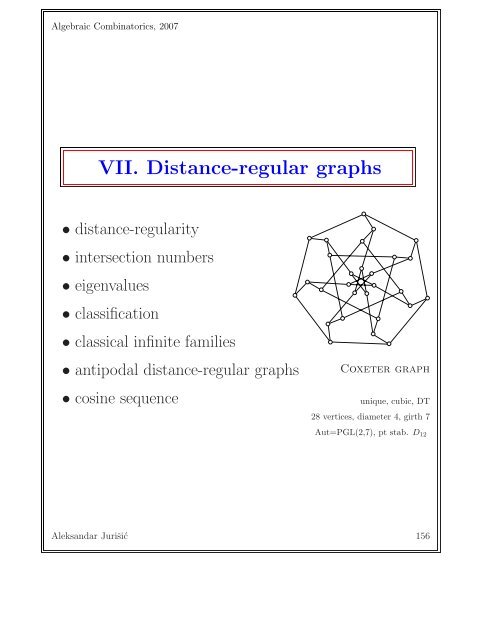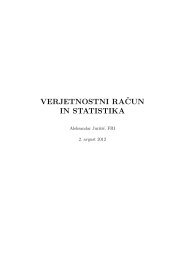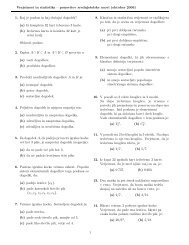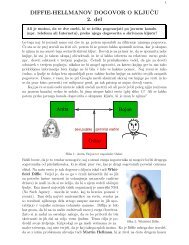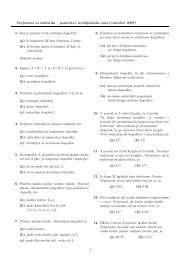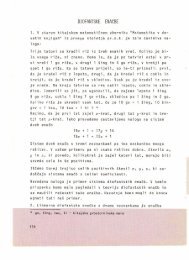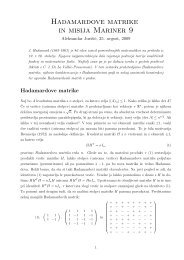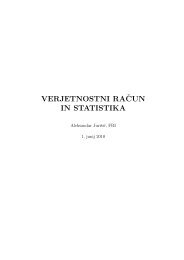VII. Distance-regular graphs
VII. Distance-regular graphs
VII. Distance-regular graphs
You also want an ePaper? Increase the reach of your titles
YUMPU automatically turns print PDFs into web optimized ePapers that Google loves.
Algebraic Combinatorics, 2007<br />
<strong>VII</strong>. <strong>Distance</strong>-<strong>regular</strong> <strong>graphs</strong><br />
• distance-<strong>regular</strong>ity<br />
• intersection numbers<br />
• eigenvalues<br />
• classification<br />
• classical infinite families<br />
• antipodal distance-<strong>regular</strong> <strong>graphs</strong><br />
• cosine sequence<br />
Coxeter graph<br />
unique, cubic, DT<br />
28 vertices, diameter 4, girth 7<br />
Aut=PGL(2,7), pt stab. D 12<br />
Aleksandar Jurišić 156
Algebraic Combinatorics, 2007<br />
<strong>Distance</strong>-<strong>regular</strong>ity:<br />
Γ graph, diameter d, ∀ x ∈ V (Γ)<br />
the distance partition {Γ 0 (x), Γ 1 (x), ...,Γ d (x)}<br />
corresponding to x<br />
x<br />
b<br />
b<br />
1<br />
c b c 2 2 i i<br />
1<br />
a a<br />
a<br />
1 2<br />
i<br />
k<br />
y<br />
C i<br />
(x,y) B i<br />
(x,y)<br />
A i(x,y)<br />
Γ(x)<br />
1<br />
Γ(x)<br />
2 Γ i-1<br />
(x) Γ(x) i<br />
Γ i+1(x)<br />
is equitable and the intersection array<br />
{b 0 , b 1 , ...,b d−1 ; c 1 ,c 2 ,...,c d } is independent of x.<br />
k<br />
1<br />
k<br />
b 1<br />
bi<br />
c<br />
k i<br />
k<br />
i<br />
c<br />
d<br />
d<br />
a 1<br />
ai<br />
a<br />
d<br />
Aleksandar Jurišić 157
Algebraic Combinatorics, 2007<br />
A small example of a distance-<strong>regular</strong> graph:<br />
(antipodal, i.e., being at distance diam. is a transitive relation)<br />
4<br />
1<br />
2 1<br />
1 4<br />
1 2 0<br />
b<br />
i<br />
0<br />
1 2 3<br />
u<br />
c<br />
i<br />
a<br />
i<br />
0<br />
0<br />
c a b 1 1<br />
b<br />
a 1<br />
c 2 2 b<br />
a<br />
c 3 3<br />
2<br />
=<br />
0 4<br />
1 1<br />
1<br />
2<br />
2<br />
4<br />
1<br />
0<br />
The above parameters are the same for each vertex u:<br />
{b 0 , b 1 , b 2 ; c 1 ,c 2 ,,c 3 } 4 2 1<br />
4 8 2<br />
= {4, 2, 1; 1, 1, 4}. 1 1 4<br />
1 2 0<br />
Aleksandar Jurišić 158
Algebraic Combinatorics, 2007<br />
Intersection numbers<br />
Set p h ij := |Γ i(u) ∩ Γ j (v)|, where ∂(u,v)=h. Then<br />
a i = p i i1, b i = p i i+1,1, c i = p i i−1,1, k i = p 0 ii,<br />
k i = p h i0 + · · · + p h id and in particular a i + b i + c i = k.<br />
A connected graph is distance-transitive when<br />
any pair of its vertices can be mapped (by a graph<br />
authomorphism, i.e., an adjacency preserving map) to<br />
any other pair of its vertices at the same distance.<br />
distance-transitivity =⇒ distance-<strong>regular</strong>ity<br />
Aleksandar Jurišić 159
Algebraic Combinatorics, 2007<br />
All the intersection numbers are determined by the<br />
numbers in the intersection array<br />
{b 0 , b 1 , . . . , b d−1 ; c 1 , c 2 , . . . , c d }<br />
of Γ. This can be proved by induction on i, using the<br />
following recurrence relation:<br />
c j+1 p r i,j+1+a j p r ij+b j−1 p r i,j−1 = c i+1 p r i+1,j+a i p r ij+b i−1 p r i−1,j<br />
obtained by a 2-way counting for vertices u and v at<br />
distance r the edges with one end in Γ i (u) and another<br />
in Γ j (v). Therefore,<br />
the intersection numbers do not depend on<br />
the choice of vertices u and v at distance r.<br />
Aleksandar Jurišić 160
Algebraic Combinatorics, 2007<br />
An arbitrary list of numbers b i and c i does not<br />
determine a distance-<strong>regular</strong> graph.<br />
It has to satisfy numerous feasiblity conditions<br />
(e.g. all intersection numbers have to be integral).<br />
One of the main questions of the theory of distance<strong>regular</strong><br />
<strong>graphs</strong> is for a given intersection array<br />
• to construct a distance-<strong>regular</strong> graph,<br />
• to prove its uniqueness,<br />
• to prove its nonexistence.<br />
Some basic properties of the intersection numbers will<br />
be collected in the following result.<br />
Aleksandar Jurišić 161
Algebraic Combinatorics, 2007<br />
Lemma. Γ distance-<strong>regular</strong>, diameter d and<br />
intersection array {b 0 , b 1 , ...,b d−1 ; c 1 , c 2 ,...,c d }.<br />
Then<br />
(i) b 0 > b 1 ≥ b 2 ≥ · · · ≥ b d−1 ≥ 1,<br />
(ii) 1 = c 1 ≤ c 2 ≤ · · · ≤ c d ,<br />
(iii) b i−1 k i−1 = c i k i for 1 ≤ i ≤ d,<br />
(iv) if i + j ≤ d, then c i ≤ b j ,<br />
(v) the sequence k 0 ,k 1 ,...,k d is unimodal, (i.e.,<br />
there exists such indices h, l (1 ≤ h ≤ l ≤ d),<br />
that k 0 < · · · < k h = · · · = k l > · · · > k d .<br />
Aleksandar Jurišić 162
Algebraic Combinatorics, 2007<br />
Proof. (i) Obviously b 0 > b 1 . Set 2 ≤ i ≤ d. Let<br />
v,u ∈ V Γ be at distance d and v = v 0 , v 1 ,...,v d = u<br />
be a path. The vertex v i has b i neighbours, that are<br />
at distance i + 1 from v. All these b i vertices are at<br />
distance i from v 1 , so b i−1 ≥ b i .<br />
(iii) The number of edges from Γ i−1 (v) to Γ i (v) is<br />
b i−1 k i−1 , while from Γ i (v) to Γ i−1 (v) is c i k i .<br />
(iv) The vertex v i has c i neighbours, that are at<br />
distance i−1 from v. All these vertices are at distance<br />
j + 1 from v i+j . Hence c i ≤ b j .<br />
The statement (ii) can be proven the same way as (i),<br />
and (v) follows directly from (i), (ii) and (iii).<br />
Aleksandar Jurišić 163
Algebraic Combinatorics, 2007<br />
Lemma. A connected graph G of diameter d is<br />
distance-<strong>regular</strong> iff ∃ a i , b i and c i such that<br />
AA i = b i−1 A i−1 +a i A i +c i+1 A i+1 for 0 ≤ i ≤ d.<br />
If G is a distance-<strong>regular</strong> graph, then A i = v i (A) for<br />
some polynomial v i (x) of degree i, for 0 ≤ i ≤ d + 1.<br />
The sequence {v i (x)} is determined with v −1 (x) = 0,<br />
v 0 (x) = 1, v 1 (x) = x and for i ∈ {0, 1, ...,d} with<br />
c i+1 v i+1 (x) = (x − a i )v i (x) − b i−1 v i−1 (x).<br />
In this sense distance-<strong>regular</strong> <strong>graphs</strong> are combinatorial<br />
representation of orthogonal polynomials.<br />
Aleksandar Jurišić 164
Algebraic Combinatorics, 2007<br />
Eigenvalues<br />
The intersection array of a distance-<strong>regular</strong> graph Γ<br />
{k,b 1 , ...,b d−2 ,b d−1 ; 1, c 2 , ...,c d−1 ,c d },<br />
i.e., the quotient graph Γ/π with the adjacency matrix<br />
⎛<br />
⎞<br />
a 0 b 0<br />
c 1 a 1 b 1 0<br />
A(G/π) =<br />
0 c 2 . .<br />
⎜ . . .<br />
, determines<br />
⎟<br />
⎝ 0 . . b d−1<br />
⎠<br />
c d a d<br />
all the eigenvalues of Γ and their multiplicities.<br />
Aleksandar Jurišić 165
Algebraic Combinatorics, 2007<br />
The vector v = ( v 0 (θ),...,v d (θ) ) T<br />
is a left eigenvector<br />
of this matrix corresponding to the eigenvalue θ.<br />
Similarly a vector w = (w 0 (θ),...,w d (θ)) T defined<br />
by w −1 (x) = 0, w 0 (x) = 1, w 1 (x) = x/k and for<br />
i ∈ {0, 1, ...,d} by<br />
xw i (x) = c i w i−1 (x) + a i w i (x) + b i w i+1 (x)<br />
is a right eigenvector of this matrix, corresponding to<br />
the eigenvalue θ.<br />
There is the following relation between coordinates of<br />
vectors w and v: w i (x)k i = v i (x).<br />
Aleksandar Jurišić 166
Algebraic Combinatorics, 2007<br />
Classification<br />
Γ distance-<strong>regular</strong>, diam. d. We say Γ is primitive,<br />
when all the distance <strong>graphs</strong> Γ 1 , . ..,Γ d are connected<br />
(and imprimitive otherwise).<br />
Theorem (Smith).<br />
An imprimitive distance-<strong>regular</strong><br />
graph is either antipodal or bipartite.<br />
The big project of classifying distance-<strong>regular</strong> <strong>graphs</strong>:<br />
(a) find all primitive distance-<strong>regular</strong> <strong>graphs</strong>,<br />
(b) given a distance-<strong>regular</strong> graph Γ, find all<br />
imprimitive <strong>graphs</strong>, which give rise to Γ.<br />
Aleksandar Jurišić 167
Algebraic Combinatorics, 2007<br />
Classical infinite families<br />
graph diameter b α β<br />
Johnson graph J(n, d) min(d, n − d) 1 1 n − d<br />
[<br />
Grassmann graph min(k, v − k) q q n−d+1<br />
]<br />
1 − 1<br />
Hammin graph H(d, n) d 1 0 n − 1<br />
Bilinear forms graph k q q − 1 q n − 1<br />
Dual polar graph q 0 q e<br />
Alternating forms graph ⌊n/2⌋ q 2 q 2 − 1 q m − 1<br />
Hermitean forms graph n −r −r − 1 −(−r) d − 1<br />
Quadratic forms graph ⌊(n + 1)/2⌋ q 2 q 2 − 1 q m − 1<br />
Aleksandar Jurišić 168
Algebraic Combinatorics, 2007<br />
The Gauss binomal coefficient [ j<br />
(<br />
i]<br />
is equal<br />
j<br />
)<br />
i<br />
for b = 1 and<br />
∏i−1<br />
b j − b k<br />
b i − b k<br />
otherwise.<br />
k=0<br />
If V is an n-dim. vector space over a finite field with b<br />
elements, then [ n<br />
m]<br />
is the number of m-dim. subspaces<br />
of V .<br />
Aleksandar Jurišić 169
Algebraic Combinatorics, 2007<br />
A distance-<strong>regular</strong> graph with diameter d is called<br />
classical, if its intersection parametres can be<br />
parametrized with four parameters (diameter d and<br />
numbers b,α and β) in the following way:<br />
[ [ [ d i i<br />
b i = ( − )(β − α ), 0 ≤ i ≤ d − 1<br />
1]<br />
1]<br />
1]<br />
c i =<br />
[ i<br />
1]<br />
(1 + α<br />
where [ j<br />
1]<br />
[ i − 1<br />
1<br />
]<br />
), 1 ≤ i ≤ d,<br />
:= 1 + b + b 2 + · · · + b j−1 .<br />
Aleksandar Jurišić 170
Algebraic Combinatorics, 2007<br />
Antipodal distane-<strong>regular</strong> <strong>graphs</strong><br />
Theorem (Van Bon and Brouwer, 1987).<br />
Most classical distance-<strong>regular</strong> <strong>graphs</strong> have no<br />
antipodal covers.<br />
Theorem (Terwilliger, 1993).<br />
P- and Q-poly. association scheme with d ≥ 3<br />
(not C n , Q n , 1 2 Q n or 1 2J(s, 2s)) is not the quotient<br />
of an antipodal P-polynomial scheme with d ≥ 7.<br />
Aleksandar Jurišić 171
Algebraic Combinatorics, 2007<br />
Theorem (A.J. 1991). H is a bipartite antipodal<br />
cover with D odd<br />
iff<br />
H ∼ = K 2 ⊗ (H/π), (i.e., bipartite double),<br />
and H/π is a generalized Odd graph.<br />
(cf. Biggs and Gardiner, also [BCN])<br />
Aleksandar Jurišić 172
Algebraic Combinatorics, 2007<br />
A generalized Odd graph of diameter d is a drg,<br />
s.t. a 1 = · · · = a d−1 = 0, a d ≠ 0)<br />
Known examples for D = 5 (and d = 2):<br />
– Desargues graph (i.e., the Double Petersen)<br />
– five-cube<br />
– the Double of Hoffman-Singleton<br />
– the Double Gewirtz<br />
– the Double 77-graph<br />
– the Double Higman-Sims<br />
Aleksandar Jurišić 173


